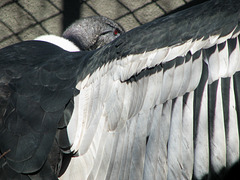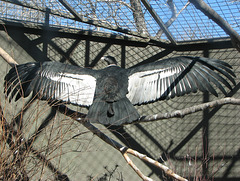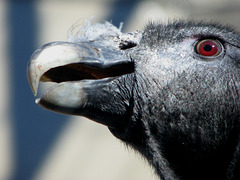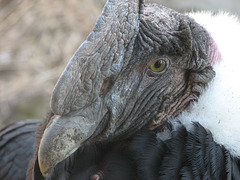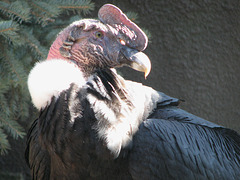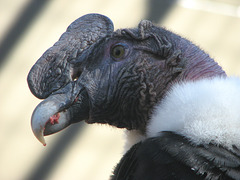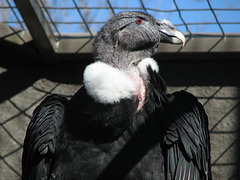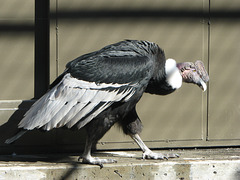Anne Elliott's photos with the keyword: Andean Condor
Lorenzo
| 20 Apr 2008 |
|
Meet Lorenzo, the male Andean Condor who now lives at the Calgary Zoo with his partner, Shirley! The wingspan of these massive birds is 9-10 feet. When you are old enough to start developing wrinkles, remember that there is always someone who is worse off than you, LOL!
"The Andean Condor (Vultur gryphus) is a species of South American bird in the New World vulture family Cathartidae and is the only member of the genus Vultur. Found in the Andes mountains and adjacent Pacific coasts of western South America, it is the largest flying land bird in the Western Hemisphere.
It is a large black vulture with a ruff of white feathers surrounding the base of the neck and, especially in the male, large white patches on the wings. The head and neck are nearly featherless, and are a dull red color, which may flush and therefore change color in response to the bird's emotional state. In the male, there is a wattle on the neck and a large, dark red comb or caruncle on the crown of the head. Unlike most birds of prey, the male is larger than the female.
The condor is primarily a scavenger, feeding on carrion. It prefers large carcasses, such as those of deer or cattle. It reaches sexual maturity at five or six years of age and roosts at elevations of 3,000 to 5,000 m (10,000 to 16,000 ft), generally on inaccessible rock ledges. One or two eggs are usually laid. It is one of the world’s longest-living birds, with a lifespan of up to 50 years." From Wikipedia.
Andean Condor
| 11 May 2009 |
|
We have a pair of these enormous Andean Condors at the Calgary Zoo. Really quite the sight to see, LOL! This handsome creature is the male : ).
"The Andean Condor (Vultur gryphus) is a species of South American bird in the New World vulture family Cathartidae and is the only member of the genus Vultur. Found in the Andes mountains and adjacent Pacific coasts of western South America, it is the largest flying land bird in the Western Hemisphere.
It is a large black vulture with a ruff of white feathers surrounding the base of the neck and, especially in the male, large white patches on the wings. The head and neck are nearly featherless, and are a dull red color, which may flush and therefore change color in response to the bird's emotional state. In the male, there is a wattle on the neck and a large, dark red comb or caruncle on the crown of the head. Unlike most birds of prey, the male is larger than the female.
The condor is primarily a scavenger, feeding on carrion. It prefers large carcasses, such as those of deer or cattle. It reaches sexual maturity at five or six years of age and roosts at elevations of 3,000 to 5,000 m (10,000 to 16,000 ft), generally on inaccessible rock ledges. One or two eggs are usually laid. It is one of the world’s longest-living birds, with a lifespan of up to 50 years." The Andean Condor is considered near threatened by the IUCN." From Wikipedia.
Outstretched
| 24 Apr 2007 |
|
One more photo of the female Andean Condor at the Calgary Zoo, to give an idea of the massive wing size.
12 feet wide
| 04 Apr 2007 |
|
This photo shows the enormous wingspan of Shirley, the recently acquired female Andean Condor at the Calgary Zoo. The wingspan can get up to 12 feet!
Portrait of Shirley
| 04 Apr 2007 |
|
A close-up of Shirley, the recently acquired female Andean Condor at the Calgary Zoo, to show the powerful bill and beautiful red eye (male has yellow). The few white feathers are from her white feather collar and not actually growing above her bill!
Hola, Lorenzo
| 04 Apr 2007 |
|
Lorenzo again at the Calgary Zoo. He is the male of a pair recently acquired by the Calgary Zoo. This photo shows the comb on top of his head as well as his yellow eyes. The female has no comb and has red eyes.
"The Andean Condor, Argentinean Condor, Bolivian Condor, Chilean Condor, Colombian Condor, Ecuadorian Condor or Peruvian Condor (Vultur gryphus), is a species of bird in one of the vulture families. It is in many regards the largest flying land bird in the Western Hemisphere and is the heaviest, but not the lengthiest, member of the order Ciconiiformes.
This condor inhabits the Andes mountains. Although it is primarily a scavenger, feeding on carrion, this species belongs to the New World vulture family Cathartidae, related to storks and not closely related to Old World vultures, which are in the family Accipitridae along with hawks, eagles and kites.
The adult plumage is of a uniform black, with the exception of a frill of white feathers nearly surrounding the base of the neck and, especially in the male, large patches or bands of white on the wings which do not appear until the completion of the first moulting. As an adaptation for hygiene, the head and neck have few feathers, exposing the skin to the sterilizing effects of dehydration and ultraviolet light at high altitudes, and are meticulously kept clean by the bird. The head is much flattened above. In the male it is crowned with a caruncle or comb, while the skin of the neck in the male lies in folds, forming a wattle. The skin of the head and neck is capable of flushing noticeably in response to emotional state, which serves to communicate between individuals.
The female, contrary to the usual rule among birds of prey, is smaller than the male.
Wild condors inhabit large territories, often traveling 250 km (150 miles) a day in search of carrion. They prefer large carcasses such as deer or cattle which they spot by looking for other scavengers, who cannot rip through the tougher hides of these larger animals with the efficiency of the larger condor. In the wild they are intermittent eaters, often going for a few days without eating, then gorging themselves on several pounds at once, sometimes to the point of being unable to lift off the ground." Taken from Wikipedia.
Flight fantasy
| 12 Apr 2007 |
|
A closer view of the majestic wing of one of the huge Andean Condors at the Calgary Zoo.
Hen-pecked
| 14 Apr 2007 |
|
Another photo of the male Andean Condor at the Calgary Zoo. Unfortunately, the lighting was really bad in their enclosure - they were either in the shade or in very bright sunlight. The poor guy was harrassed by his mate a lot of the time!
Female Andean Condor
| 27 Mar 2007 |
|
This is Shirley, a 20-year-old Andean Condor which has recently been brought to the Calgary Zoo. They don't use their vocal chords. Often live up to 75 years in captivity. These majestic birds are increasing in numbers and making a comeback.
Male Andean Condor
| 27 Mar 2007 |
|
This is Lorenzo, a 20-year-old Andean Condor which has recently been brought to the Calgary Zoo. They don't use their vocal chords. Often live up to 75 years in captivity. These majestic birds are increasing in numbers and making a comeback.
Red-eye
| 30 Mar 2007 |
|
Shirley, the Andean Condor that was recently acquired by the Calgary Zoo, along with a male called Lorenzo. Don't you just love that collar of delicate white feathers? She looks as if she is dressed and ready to go out on the town! Wingspan up to 12 feet!
Andean Condor
| 28 Mar 2007 |
|
This is Lorenzo, a male Andean Condor, one of a pair that was brought to the Calgary Zoo about two weeks ago.
"The Andean Condor, Argentinean Condor, Bolivian Condor, Chilean Condor, Colombian Condor, Ecuadorian Condor or Peruvian Condor (Vultur gryphus), is a species of bird in one of the vulture families. It is in many regards the largest flying land bird in the Western Hemisphere and is the heaviest, but not the lengthiest, member of the order Ciconiiformes.
This condor inhabits the Andes mountains. Although it is primarily a scavenger, feeding on carrion, this species belongs to the New World vulture family Cathartidae, related to storks and not closely related to Old World vultures, which are in the family Accipitridae along with hawks, eagles and kites.
The adult plumage is of a uniform black, with the exception of a frill of white feathers nearly surrounding the base of the neck and, especially in the male, large patches or bands of white on the wings which do not appear until the completion of the first moulting. As an adaptation for hygiene, the head and neck have few feathers, exposing the skin to the sterilizing effects of dehydration and ultraviolet light at high altitudes, and are meticulously kept clean by the bird. The head is much flattened above. In the male it is crowned with a caruncle or comb, while the skin of the neck in the male lies in folds, forming a wattle. The skin of the head and neck is capable of flushing noticeably in response to emotional state, which serves to communicate between individuals.
The female, contrary to the usual rule among birds of prey, is smaller than the male.
Wild condors inhabit large territories, often traveling 250 km (150 miles) a day in search of carrion. They prefer large carcasses such as deer or cattle which they spot by looking for other scavengers, who cannot rip through the tougher hides of these larger animals with the efficiency of the larger condor. In the wild they are intermittent eaters, often going for a few days without eating, then gorging themselves on several pounds at once, sometimes to the point of being unable to lift off the ground." Taken from Wikipedia.
Winner of the staring contest
| 28 Mar 2007 |
|
This is Lorenzo, a male Andean Condor, one of a pair brought to the Calgary Zoo about two weeks ago. Males have browny/yellow eyes, and females have red eyes.
"The Andean Condor, Argentinean Condor, Bolivian Condor, Chilean Condor, Colombian Condor, Ecuadorian Condor or Peruvian Condor (Vultur gryphus), is a species of bird in one of the vulture families. It is in many regards the largest flying land bird in the Western Hemisphere and is the heaviest, but not the lengthiest, member of the order Ciconiiformes.
This condor inhabits the Andes mountains. Although it is primarily a scavenger, feeding on carrion, this species belongs to the New World vulture family Cathartidae, related to storks and not closely related to Old World vultures, which are in the family Accipitridae along with hawks, eagles and kites.
The adult plumage is of a uniform black, with the exception of a frill of white feathers nearly surrounding the base of the neck and, especially in the male, large patches or bands of white on the wings which do not appear until the completion of the first moulting. As an adaptation for hygiene, the head and neck have few feathers, exposing the skin to the sterilizing effects of dehydration and ultraviolet light at high altitudes, and are meticulously kept clean by the bird. The head is much flattened above. In the male it is crowned with a caruncle or comb, while the skin of the neck in the male lies in folds, forming a wattle. The skin of the head and neck is capable of flushing noticeably in response to emotional state, which serves to communicate between individuals.
The female, contrary to the usual rule among birds of prey, is smaller than the male.
Wild condors inhabit large territories, often traveling 250 km (150 miles) a day in search of carrion. They prefer large carcasses such as deer or cattle which they spot by looking for other scavengers, who cannot rip through the tougher hides of these larger animals with the efficiency of the larger condor. In the wild they are intermittent eaters, often going for a few days without eating, then gorging themselves on several pounds at once, sometimes to the point of being unable to lift off the ground." Taken from Wikipedia.
Jump to top
RSS feed- Anne Elliott's latest photos with "Andean Condor" - Photos
- ipernity © 2007-2025
- Help & Contact
|
Club news
|
About ipernity
|
History |
ipernity Club & Prices |
Guide of good conduct
Donate | Group guidelines | Privacy policy | Terms of use | Statutes | In memoria -
Facebook
Twitter



